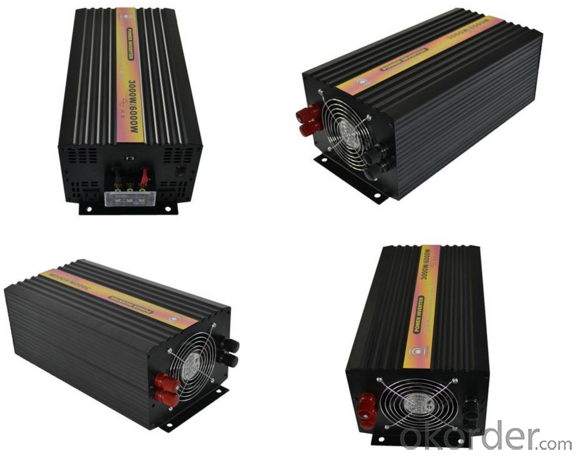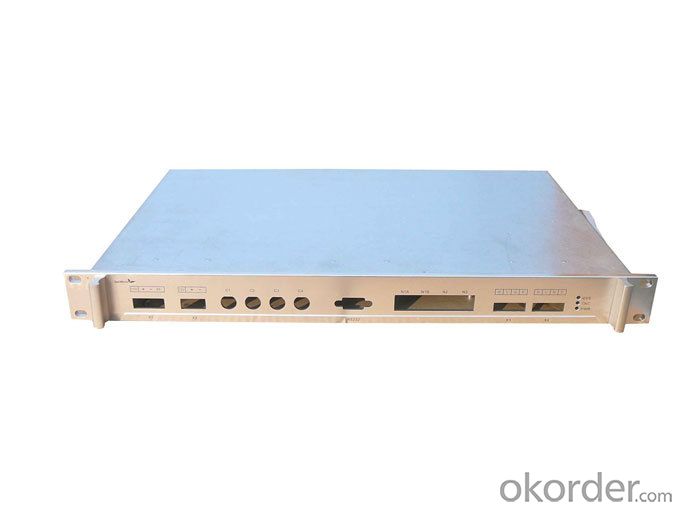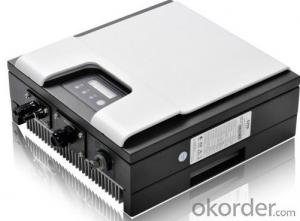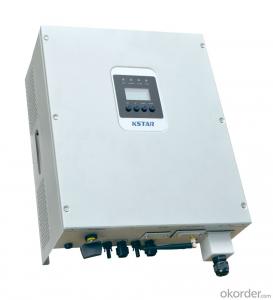Single Phase Inverter Second Generation 2.5k Solar Inverter made in China
- Loading Port:
- Shanghai
- Payment Terms:
- TT OR LC
- Min Order Qty:
- 0 watt
- Supply Capability:
- 10000 watt/month
OKorder Service Pledge
OKorder Financial Service
You Might Also Like
Description of Single Phase Inverter Second Generation 2.5k Solar Inverter
Solar ac power system consists of solar panels, charge controllers, inverter and battery; Solar energy does not include inverter dc power system. Inverter is a kind of power conversion device, inverter by incentives can be divided into self-excited oscillation inverter and separately excited oscillation inverter.
Features of Single Phase Inverter Second Generation 2.5k Solar Inverter
Standard 10 years warranty, 5-15 years optional
Built-in Gprs as option
Built-in Wifi as option
Smaller and lighter, only 9.6kg
High performance DSP for algorithm control
VDE-AR-N 4105 certification
New topology design
Dual MPPT design
Multi-button touch interface
LCD screen visible at night
Have anti-shading function
Advantages of Single Phase Inverter Second Generation 2.5k Solar Inverter
Longer life cycle
Plug and play
Free monitoring through our webportal
Very lower internal temperature
Easy transportation and installation
Faster CPU speed
Adjustable active and reactive power
Maximum conversion effciency up to 97.7%,Euro up to 97.0%
Real-time data readable at night
User friendly operation
Technical Data of Single Phase Inverter Second Generation 2.5k Solar Inverter
Type | Omniksol-2.5k-TL2-S |
Input(DC) | |
Max.PV Power | 2800W |
Max,DC Voltage | 500V |
Nominal DC Voltage | 360V |
Operating MPPT Voltage Range | 120-450V |
MPPT Voltage Range at Nominal Power | 150-450V |
Start up DC Voltage | 150V |
Turn off DC Voltage | 120V |
Max, DC Current | 18A/18A |
Max, Short Cicuit Current for each MPPT | 20A/20A |
Number of MPP trackers | 1 |
Number of DC Connection for each MPPT | 1 |
DC Connection Type | MC4 connector |
Output(AC) | |
Max,AC Apparent Power | 2750VA |
Nominal AC Power (cos phi = 1) | 2500W |
Nominal Grid Voltage | 220V/230V/240V |
Nominal Grid Frequency | 50Hz/60Hz |
Max, AC Current | 12.5A |
Grid Voltage Range* | 185-276V |
Grid Frequency Range* | 45-55Hz/55-65Hz |
Power Factor | 0.9 capacitive... 0.9 inductive |
Total Harmonic Distortion(THD) | <2% |
Feed in Starting Power | 30W |
Night time Power Consumption | <1W |
Standby Consumption | 6W |
AC Connection Type | Plug-in connertor |
Efficiency | |
Max,Efficiency | 97.7% |
Euro Efficiency | 96.9% |
MPPT Efficiency | 99.9% |
Safety and Protection | |
DC Insulation Monitoring | Yes |
DC Switch | Optional |
Residual Current Monitoring Unit (RCMU) | Integrated |
Grid Monitoring with Anti-islanding | Yes |
Protection Class | Ⅰ(According to IEC 62103) |
Overvoltage Category |
PVⅡ/Mains Ⅲ(According to IEC 62109-1)
|
Electricity Fuse Protection | Yes |
Reference Standard | |
Safety Standard | EN 62109, AS/NZS 3100 |
EMC Standard | EN 6100-6-1, EN 6100-6-2, EN 6100-6-3 EN 6100-6-4, EN 6100-3-2, EN 6100-3-3 |
Grid Standard | VDE-AR-N4105. VDE-0126-1-1,G83/1,EN 50438,RD1699,CEI 0-21, AS4777,C10/C11 |
Physical Structure | |
Dimensions | 343x281x150mm |
Weight | 9.9kg |
Environmental Protection Rating | IP 65 (According to IEC 60529) |
Cooling Concept | Internal fan convection |
Mounting Information | Wall bracke |
General Data | |
Operating Temperature Range | -25℃ to +60℃(derating above 45℃) |
Relative Humidity | 0% to 98%, no condensation |
Max. Altitude (above sea level) | 2000m |
Noise Type | <40dB |
Isolation Type | Transformerless |
Display | 3 LED ,Backlight, 4x20 Character LCD |
Data Communication | RS485(WiFi, GRPS integrated) |
Computer Communication | USB |
Standard Warranty | 10 Years (5-15 years optional) |
IMages of Single Phase Inverter Second Generation 2.5k Solar Inverter



FAQ
Q: Do you have the CE, TUV, UL Certification?
A: We’ve already passed all the tests, and any certificate is available.
Q: Have you ever sold your products to companies in my country?
A: Of course, we have customers in all general PV markets, but I think we should expand our market share along with the market growth.
Q: When did your company set up? You are a new company, how can I believe your quality?
A: We entered into Solar PV industry in 2005, now we have several plants in manufacturing of a-Si and c-Si panels, and our capacity is 220MW per year. Till now we have already passed all the tests by authorized laboratories, e.g. TUV, CE, UL.
Q: Can you help us install the module if we cooperate with you?
A: We haven’t entered into installation sector, but we have the plan in near future.
Q: How do you pack your products?
A: We have rich experience on how to pack the panels to make sure the safety on shipment when it arrives at the destination.
Q: Can you do OEM for us?
A: Yes, we can.
Q: Can we visit your factory?
A: Surely, I will arrange the trip basing on your business schedule.
- Q:What is the role of a solar inverter in preventing electrical hazards?
- The role of a solar inverter in preventing electrical hazards is to convert the direct current (DC) power generated by solar panels into alternating current (AC) power that can be used in homes and businesses. By regulating the voltage and frequency of the electricity, the inverter ensures that the power is safe and compatible with the electrical grid. Additionally, solar inverters have built-in safety features such as ground fault protection and rapid shutdown mechanisms, which help prevent electrical hazards such as fires, shocks, and damage to the system.
- Q:Can a solar inverter be repaired or does it need to be replaced?
- A solar inverter can be repaired in many cases, depending on the specific issue it is facing. However, there are instances where replacement may be necessary, especially if the inverter is old, damaged beyond repair, or if repairs would be more expensive than getting a new one. It is recommended to consult a professional to assess the situation and determine the most cost-effective solution.
- Q:How does a solar inverter handle voltage regulation?
- A solar inverter handles voltage regulation by continuously monitoring the incoming voltage from the solar panels and adjusting its output voltage accordingly. It ensures that the voltage produced by the solar panels is converted to the appropriate level for efficient use in the electrical system. This helps to maintain a stable and consistent voltage output, protecting the connected devices and optimizing energy conversion.
- Q:What is the difference between a single-phase and three-phase solar inverter?
- A single-phase solar inverter is designed to convert the direct current (DC) produced by a solar panel into alternating current (AC) for use in single-phase electrical systems. It is typically used in residential or small-scale solar installations. On the other hand, a three-phase solar inverter is capable of converting DC power into AC power for use in three-phase electrical systems, which are commonly found in commercial or industrial settings. The main difference lies in the number of phases supported and the scale of the electrical system they are designed for.
- Q:What are the indicators of a faulty solar inverter?
- Some indicators of a faulty solar inverter may include a complete loss of power generation from the solar panels, flickering or inconsistent power output, unusual noises coming from the inverter, error messages or warning lights displayed on the inverter's screen, and a noticeable decrease in the overall efficiency of the solar system.
- Q:How does a solar inverter affect the overall system reliability in harsh environments?
- A solar inverter plays a crucial role in enhancing the overall system reliability in harsh environments. It acts as the interface between the solar panels and the electrical grid, converting the direct current (DC) generated by the panels into alternating current (AC) that can be used in our homes or businesses. In harsh environments with extreme temperatures, high humidity, or dust and debris, the inverter's design and components must be specifically engineered to withstand these conditions. Robust protection against environmental factors ensures the inverter's longevity and uninterrupted operation. Additionally, advanced features such as temperature regulation, fault detection, and rapid shutdown mechanisms further enhance system reliability, ensuring consistent power generation and minimal downtime.
- Q:How do you choose the right output voltage for a solar inverter?
- When choosing the right output voltage for a solar inverter, several factors should be considered. Firstly, it is essential to match the inverter's output voltage with the electrical system or grid requirements of your location. This typically involves understanding the voltage and frequency standards set by the utility company or relevant regulatory body. Additionally, the output voltage should align with the capacity and specifications of the solar panels or array being used. The inverter must be able to handle the maximum voltage and current produced by the solar panels to optimize power generation. Furthermore, the load requirements of the electrical devices or appliances that will connect to the inverter should be taken into account. It is crucial to ensure that the inverter's output voltage is compatible with the voltage needs of the equipment, avoiding any potential damage or inefficiencies. Overall, selecting the appropriate output voltage for a solar inverter involves considering the electrical system standards, solar array specifications, and load requirements to attain optimal performance and compatibility.
- Q:What are the typical efficiency ranges for different types of solar inverters?
- The typical efficiency ranges for different types of solar inverters can vary depending on factors such as the technology used, the quality of the inverter, and the specific application. However, in general, string inverters typically have efficiency ranges of around 95% to 98%, while microinverters can achieve efficiencies ranging from 95% to 99%. On the other hand, central inverters, which are commonly used in large-scale solar installations, often have efficiency ranges of 97% to 99%. It's important to note that these are average ranges, and actual efficiency can vary depending on various factors and specific product specifications.
- Q:How is a solar inverter connected to the solar panels?
- A solar inverter is connected to solar panels through a direct current (DC) connection. The DC power generated by the solar panels is sent to the inverter, which converts it into alternating current (AC) power that can be used to power electrical devices or be fed into the grid.
- Q:What is the importance of surge protection in a solar inverter?
- Surge protection is crucial in a solar inverter as it safeguards the system against voltage spikes or power surges. These surges can occur due to lightning strikes, grid fluctuations, or other electrical disturbances, and can potentially damage the sensitive electronics in the inverter. Surge protection devices divert excessive voltage away from the solar inverter, preventing costly damage and ensuring the efficient and uninterrupted operation of the solar power system.
1. Manufacturer Overview |
|
|---|---|
| Location | |
| Year Established | |
| Annual Output Value | |
| Main Markets | |
| Company Certifications | |
2. Manufacturer Certificates |
|
|---|---|
| a) Certification Name | |
| Range | |
| Reference | |
| Validity Period | |
3. Manufacturer Capability |
|
|---|---|
| a)Trade Capacity | |
| Nearest Port | |
| Export Percentage | |
| No.of Employees in Trade Department | |
| Language Spoken: | |
| b)Factory Information | |
| Factory Size: | |
| No. of Production Lines | |
| Contract Manufacturing | |
| Product Price Range | |
Send your message to us
Single Phase Inverter Second Generation 2.5k Solar Inverter made in China
- Loading Port:
- Shanghai
- Payment Terms:
- TT OR LC
- Min Order Qty:
- 0 watt
- Supply Capability:
- 10000 watt/month
OKorder Service Pledge
OKorder Financial Service
Similar products
New products
Hot products
Hot Searches
Related keywords































